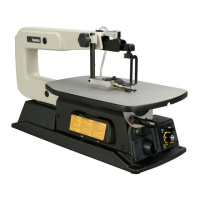
Do you have a question about the Makita SJ401 and is the answer not in the manual?
Ensure all parts are present, undamaged, and functioning before operation.
Safety is a combination of common sense and alertness during operation.
Bolt saw securely to a workbench or stand for stability.
Avoid flammable environments; keep work area well-lit and clear.
Roll sleeves, avoid loose clothing/jewelry, tie back hair.
Avoid cutting pieces too small to hold by hand outside the guard.
Avoid positions where a slip could move hands into the blade.
Ensure blade teeth point down; support workpiece to prevent lifting.
Adjust blade tension correctly to prevent breakage.
Support large pieces, hold firmly, feed slowly, and use caution with irregular shapes.
Turn off, unplug, wedge kerf, and back blade out carefully.
Never leave running saw unattended; turn off before clearing table.
Connect to a properly grounded 120V outlet; do not alter grounding prong.
Use correct gauge extension cords to prevent power loss and overheating.
Lists necessary tools like screwdrivers, wrenches, and a combination square.
Check all received parts against the provided list.
Do not plug in until assembly is complete; check for missing parts.
Identifies major parts of the scroll saw via a diagram and labels.
Detailed explanations for each identified component of the scroll saw.
Defines key terms used in the manual, such as Kerf, Leading Edge, and Blade Tooth Set.
Instructions and hardware recommendations for securing the saw to a workbench.
How to adjust and lock the table for horizontal or bevel cuts up to 45 degrees.
How to adjust the hold down foot to contact the workpiece properly.
Positioning the dust blower for effective dust removal during cutting.
Steps to ensure the degree scale pointer accurately reflects the table angle.
Detailed steps for installing plain end blades using set screws.
Procedure for removing plain end blades using the blade change rod and wrench.
How to activate the saw by pulling out the speed control/on-off knob.
How to deactivate the saw by pushing in the speed control/on-off knob.
Securing the knob with a padlock to prevent accidental startup.
Guidance on guiding wood, blade direction, feeding speed, and blade selection.
Step-by-step guide for creating internal cuts without breaking the workpiece perimeter.
Disconnect power and check saw for damage or obstructions before use.
Ensure workpiece is free of foreign objects and plan cuts carefully.
Plan workpiece holding, use jigs for small pieces, and avoid awkward positions.
Procedures to safely clear jammed material by powering off and unplugging.
Guidance on choosing the right blade width, thickness, and speed for different materials.
Apply paste wax to the work table for smoother wood gliding.
Replace damaged cords immediately; do not service motor internals.
Instructions for lubricating arm bearings at specified intervals.
Provides a visual representation of the saw's electrical connections for reference.
Comprehensive list of all parts with corresponding numbers and descriptions.
Further exploded views illustrating assembly components and their relationships.
Continues the detailed list of parts, encompassing a wider range of components.
Addresses issues causing blades to break and provides corrective actions.
Diagnoses reasons for motor non-operation and suggests solutions.
Identifies causes of vibration and offers remedies for proper operation.